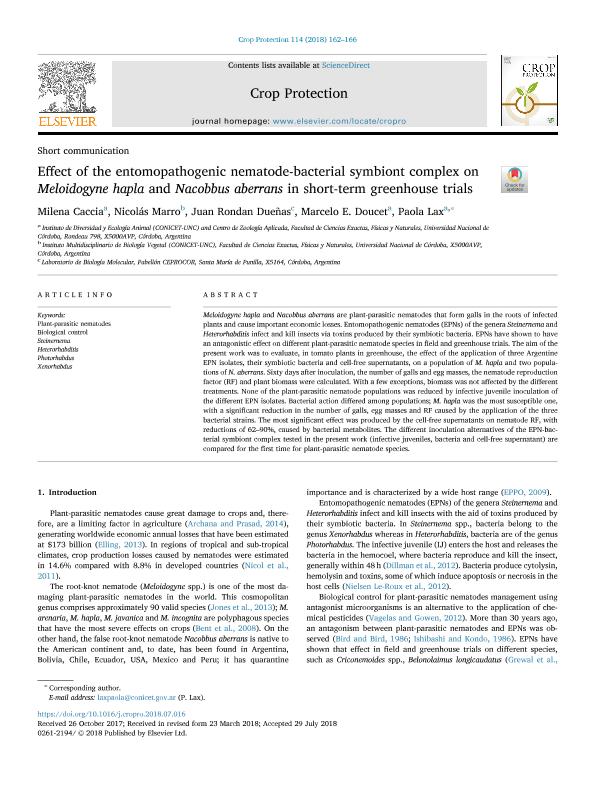Mostrar el registro sencillo del ítem
dc.contributor.author
Caccia, Milena Guadalupe

dc.contributor.author
Marro, Nicolás Alejandro

dc.contributor.author
Rondan Dueñas, Juan

dc.contributor.author
Doucet, Marcelo Edmundo

dc.contributor.author
Lax, Paola

dc.date.available
2019-10-21T14:36:54Z
dc.date.issued
2018-12
dc.identifier.citation
Caccia, Milena Guadalupe; Marro, Nicolás Alejandro; Rondan Dueñas, Juan; Doucet, Marcelo Edmundo; Lax, Paola; Effect of the entomopathogenic nematode-bacterial symbiont complex on Meloidogyne hapla and Nacobbus aberrans in short-term greenhouse trials; Elsevier; Crop Protection; 114; 12-2018; 162-166
dc.identifier.issn
0261-2194
dc.identifier.uri
http://hdl.handle.net/11336/86582
dc.description.abstract
Meloidogyne hapla and Nacobbus aberrans are plant-parasitic nematodes that form galls in the roots of infected plants and cause important economic losses. Entomopathogenic nematodes (EPNs) of the genera Steinernema and Heterorhabditis infect and kill insects via toxins produced by their symbiotic bacteria. EPNs have shown to have an antagonistic effect on different plant-parasitic nematode species in field and greenhouse trials. The aim of the present work was to evaluate, in tomato plants in greenhouse, the effect of the application of three Argentine EPN isolates, their symbiotic bacteria and cell-free supernatants, on a population of M. hapla and two populations of N. aberrans. Sixty days after inoculation, the number of galls and egg masses, the nematode reproduction factor (RF) and plant biomass were calculated. With a few exceptions, biomass was not affected by the different treatments. None of the plant-parasitic nematode populations was reduced by infective juvenile inoculation of the different EPN isolates. Bacterial action differed among populations; M. hapla was the most susceptible one, with a significant reduction in the number of galls, egg masses and RF caused by the application of the three bacterial strains. The most significant effect was produced by the cell-free supernatants on nematode RF, with reductions of 62–90%, caused by bacterial metabolites. The different inoculation alternatives of the EPN-bacterial symbiont complex tested in the present work (infective juveniles, bacteria and cell-free supernatant) are compared for the first time for plant-parasitic nematode species.
dc.format
application/pdf
dc.language.iso
eng
dc.publisher
Elsevier

dc.rights
info:eu-repo/semantics/openAccess
dc.rights
Atribución-NoComercial-CompartirIgual 2.5 Argentina (CC BY-NC-SA 2.5 AR)
dc.rights.uri
https://creativecommons.org/licenses/by-nc-sa/2.5/ar/
dc.subject
BIOLOGICAL CONTROL
dc.subject
HETERORHABDITIS
dc.subject
PHOTORHABDUS
dc.subject
PLANT-PARASITIC NEMATODES
dc.subject
STEINERNEMA
dc.subject
XENORHABDUS
dc.subject.classification
Otras Ciencias Biológicas

dc.subject.classification
Ciencias Biológicas

dc.subject.classification
CIENCIAS NATURALES Y EXACTAS

dc.title
Effect of the entomopathogenic nematode-bacterial symbiont complex on Meloidogyne hapla and Nacobbus aberrans in short-term greenhouse trials
dc.type
info:eu-repo/semantics/article
dc.type
info:ar-repo/semantics/artículo
dc.type
info:eu-repo/semantics/publishedVersion
dc.date.updated
2019-10-16T14:24:33Z
dc.journal.volume
114
dc.journal.pagination
162-166
dc.journal.pais
Países Bajos

dc.journal.ciudad
Amsterdam
dc.description.fil
Fil: Caccia, Milena Guadalupe. Consejo Nacional de Investigaciones Científicas y Técnicas. Centro Científico Tecnológico Conicet - Córdoba. Instituto de Diversidad y Ecología Animal. Universidad Nacional de Córdoba. Facultad de Ciencias Exactas Físicas y Naturales. Instituto de Diversidad y Ecología Animal; Argentina
dc.description.fil
Fil: Marro, Nicolás Alejandro. Consejo Nacional de Investigaciones Científicas y Técnicas. Centro Científico Tecnológico Conicet - Córdoba. Instituto Multidisciplinario de Biología Vegetal. Universidad Nacional de Córdoba. Facultad de Ciencias Exactas Físicas y Naturales. Instituto Multidisciplinario de Biología Vegetal; Argentina
dc.description.fil
Fil: Rondan Dueñas, Juan. Pabellón CEPROCOR. Laboratorio de Biología Molecular; Argentina
dc.description.fil
Fil: Doucet, Marcelo Edmundo. Consejo Nacional de Investigaciones Científicas y Técnicas. Centro Científico Tecnológico Conicet - Córdoba. Instituto de Diversidad y Ecología Animal. Universidad Nacional de Córdoba. Facultad de Ciencias Exactas Físicas y Naturales. Instituto de Diversidad y Ecología Animal; Argentina
dc.description.fil
Fil: Lax, Paola. Consejo Nacional de Investigaciones Científicas y Técnicas. Centro Científico Tecnológico Conicet - Córdoba. Instituto de Diversidad y Ecología Animal. Universidad Nacional de Córdoba. Facultad de Ciencias Exactas Físicas y Naturales. Instituto de Diversidad y Ecología Animal; Argentina
dc.journal.title
Crop Protection

dc.relation.alternativeid
info:eu-repo/semantics/altIdentifier/doi/http://dx.doi.org/10.1016/j.cropro.2018.07.016
dc.relation.alternativeid
info:eu-repo/semantics/altIdentifier/url/https://www.sciencedirect.com/science/article/pii/S0261219418302035
Archivos asociados
